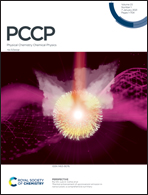Effect of Mn doping on the electron injection in CdSe/TiO2 quantum dot sensitized solar cells†
Abstract
Promotion in power conversion efficiency is an appealing task for quantum dot-sensitized solar cells that have emerged as promising materials for the utilization of clean and sustainable energy. Doping of Mn atoms into quantum dots (QD) has been proven to be one of the effective approaches, although the origin of such a promotion remains controversial. While several procedures are involved in the power conversion process, electron injection from the QD to the semiconductor oxide substrate is focused on in this work using first-principles calculations. Based on the Marcus theory, the electron injection rates are evaluated for the quantum dot-sensitized solar cell models in which the pure and Mn-doped core–shell CdSe clusters are deposited on a semiconductor titanium dioxide substrate. Enhanced rates are obtained for the Mn-doped structure, which is in qualitative agreement with the experiments. A large number of dominant injection channels and strong QD–substrate coupling are responsible for the Mn-induced rate enhancement, which could be achieved by manipulating the band structure mapping between the QD and the semiconductor oxide. By addressing the role of an Mn dopant in the electron injection process, strategies for the promotion of electron injection rates are proposed for the design of quantum dot-sensitized solar cells.



 Please wait while we load your content...
Please wait while we load your content...